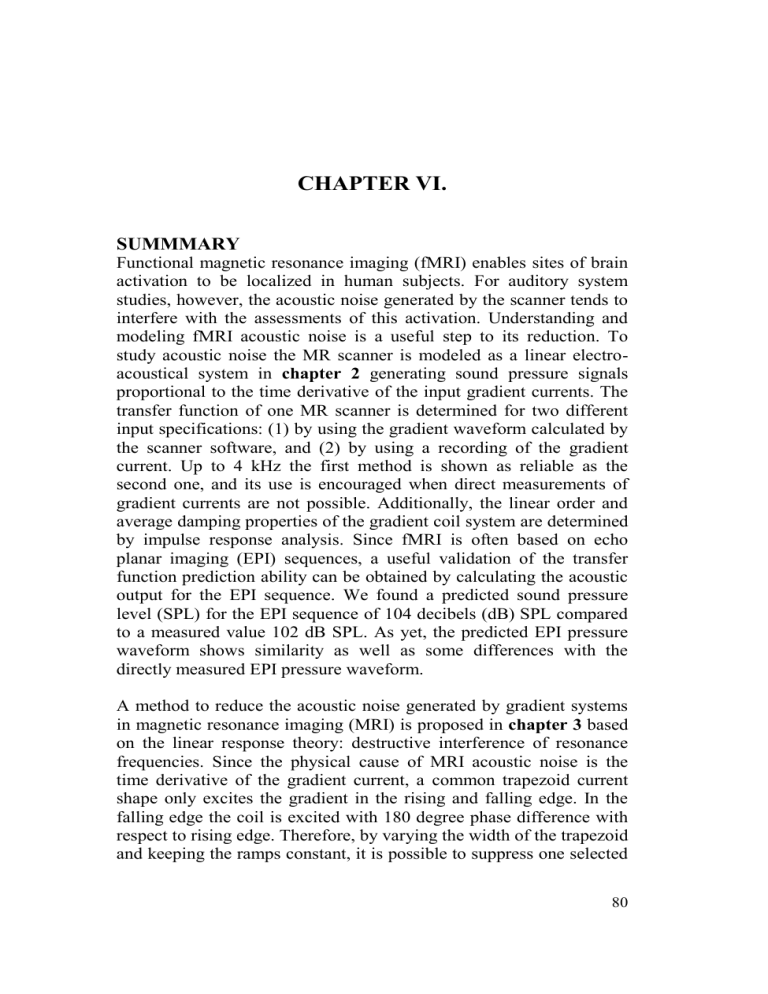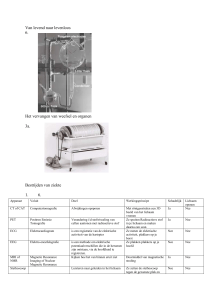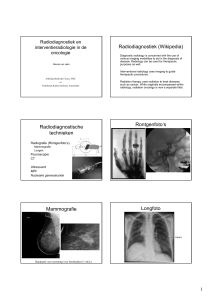
CHAPTER VI.
SUMMMARY
Functional magnetic resonance imaging (fMRI) enables sites of brain
activation to be localized in human subjects. For auditory system
studies, however, the acoustic noise generated by the scanner tends to
interfere with the assessments of this activation. Understanding and
modeling fMRI acoustic noise is a useful step to its reduction. To
study acoustic noise the MR scanner is modeled as a linear electroacoustical system in chapter 2 generating sound pressure signals
proportional to the time derivative of the input gradient currents. The
transfer function of one MR scanner is determined for two different
input specifications: (1) by using the gradient waveform calculated by
the scanner software, and (2) by using a recording of the gradient
current. Up to 4 kHz the first method is shown as reliable as the
second one, and its use is encouraged when direct measurements of
gradient currents are not possible. Additionally, the linear order and
average damping properties of the gradient coil system are determined
by impulse response analysis. Since fMRI is often based on echo
planar imaging (EPI) sequences, a useful validation of the transfer
function prediction ability can be obtained by calculating the acoustic
output for the EPI sequence. We found a predicted sound pressure
level (SPL) for the EPI sequence of 104 decibels (dB) SPL compared
to a measured value 102 dB SPL. As yet, the predicted EPI pressure
waveform shows similarity as well as some differences with the
directly measured EPI pressure waveform.
A method to reduce the acoustic noise generated by gradient systems
in magnetic resonance imaging (MRI) is proposed in chapter 3 based
on the linear response theory: destructive interference of resonance
frequencies. Since the physical cause of MRI acoustic noise is the
time derivative of the gradient current, a common trapezoid current
shape only excites the gradient in the rising and falling edge. In the
falling edge the coil is excited with 180 degree phase difference with
respect to rising edge. Therefore, by varying the width of the trapezoid
and keeping the ramps constant, it is possible to suppress one selected
80
frequency and its higher harmonics. This value is matched to one of
the prominent resonance frequency of the gradient coil system. The
idea of cancelling a single frequency is extended to a second
frequency using two successive trapezoid shape pulses presented at a
selected interval. Sound pressure level (SPL) reduction of 6 and 10 dB
is found for the two trapezoid shapes and a single pulse shape,
respectively. The proposed pulse shapes are additionally tested in a
simulated echo planar imaging (EPI) read out train obtaining SPL
reduction of 12 dB for the best case.
The study in chapter 4 aims at a quantitative approach of noise
reduction; we want to obtain physical and subjective magnitude
measures of the acoustic scanner noise. This is achieved by
performing a psychophysical matching experiment between five
different echo planar imaging (EPI) sequences and a 1/3 octave band
of pink noise, centered at 1 KHz. Additionally, three simulated noise
signals (for one EPI sequence) produced by x, y and z gradient coil
direction respectively were matched with the 1/3 octave band of pink
noise. In nine subjects with normal hearing we found that the
subjective measures of these 6 sounds do not increase linearly with the
sound pressure levels (SPL) of the input signals. This study supports
our working hypothesis that as long as we do not have a full
understanding of the relation between the acoustic properties of EPI
noise and its subjective percept, its characterization and the estimated
subjective effects should consist of both (physical and subjective
measures). The implication is that for development of an effective
fMRI acoustic noise reduction technique the perceived (subjective)
loudness characteristics of this noise should be more extensively
studied and combined with well known physical magnitudes given by
current sound analyzer technology.
Electro-acoustical characterization of one magnetic resonance imaging
(MRI) gradient coil system in chapter 5 was studied in six different
locations inside and outside the scanner bore. We want to obtain
qualitative and quantitative effects of MRI bore enclosure in electroacoustical transfer function estimation. This is achieved by estimating
the gradient coil system resonance frequencies and reverberation time
at different locations. The same two main resonance frequencies per
coil are found to be maxima at all six transfer function gain locations.
Across different coils, the X and Y direction present common transfer
81
function gain maxima around 648 Hz (mean value) and 1073 Hz
(mean value). The former is expected to represent the gradient coil
bending mode shape or so called banana-shape mode of the vibrating
structure. The Z direction coil presents transfer function gain maxima
around 1274 Hz and 1554 Hz. The former (1274 Hz) is expected to
represent the gradient coil radial mode shape or so called cone-shape
mode of the vibrating structure. The overall reverberation time and
electro-acoustical transfer function shape per coil is comparable to
some extent in all locations. These findings suggest a minimum MRI
bore enclosure effect in electro-acoustical transfer function estimation
for our facility.
SAMENVATTING
Functional magnetic resonance imaging (fMRI) maakt het mogelijk
actieve gebieden in de hersenen to localiseren. Echter, bij de
bestudering van het auditieve system is er een gerede kans dat het
door de scanner gegenereerde geluid de bepaling van deze actieve
gebieden direct beinvloed. Een nuttige stap in de minimaliseren van
die invloed bestaat in het analyseren en modelleren van dit
stoorgeluid. Om het door gegenereerde geluid te analyseren wordt in
hoofdstuk 2 de MR-scanner gemodelleerd als een elektro-akoestisch
systeem dat een geluidsdruk genereert die evenredig is met de
tijdafgeleide van de input-gradient-stromen. De overdrachtsfunctie
van en MR-scanner is bepaald voor twee verschillende inputspecificaties: (1) gebruik makend van de gradientgolfvorm die
berekend wordt door de scannersoftware, en (2) door gebruik te
maken van gemeten gradientstroom. Voor frequenties tot 4 kHz blijkt
de eerste methode even betrouwbaar als de tweede, en dat is in ieder
geval de te gebruiken methode als directe meting van de
gradientstroom niet mogelijk is. De orde en de dempingparameters
van het gradientspoel-systeem worden bepaald door de
impulsresponsie te meten. Omdat fMRI vaak gebruik maakt van
zogenaamde EPI-pulsreeksen is de schatting van de akoestische
response op een EPI-pulsreeks een nuttige test van de bruibaarheid
van de methode. We voorspelden voor de EPI-pulsreeks en
geluidsniveau van 104 dB (SPL), voor een signaal waar directe meting
een waarde van 102 dB (SPL) leverde. Vooralsnog laat de voorspelde
geluidsdrukgolfvorm zowel overeenkomsten als verschillen zien met
de direct gemeten versie.
82
In hoofdstuk 3 wordt een methode gepresenteerd om het akoestische
lawaai te reduceren, een methode die is gebaseerd op lineaire
systeemtheorie: destructieve interferentie van resonantie-frequenties.
Omdat de tijdafgeleide van de gradientstroom de fysische bron van
MRI-geluid is, geldt voor de standaard trapeziumvorm voor de stroom
dat akoestische excitatie optreedt bij de stijgende en dalende flanken
van de trapezia. De door van de dalende flank gegenereerde golf is in
tegenfase met die van de stijgende flank. Daarom kan door
verschuiving van de afstand tussen de flanken een bepaalde frequentie
(en diens boventonen) onderdrukt worden. Deze frequentie wordt
afgestemd op de sterkste akoestische resonantiefrequentie van het
systeem. Dit idee wordt ook gebruikt om een tweede piek te
onderdrukken, daarbij gebruik makend van een tweede trapeziumduur.
Hiermee werden niveaureducties bereikt van 6 en 10 dB SPL.
Toepassing op en EPI-reeks leverde een in het beste geval een reductie
van 12 dB op.
Hoofdstuk 4 richt zich op een kwantittatieve aanpak van de
luidheidsreductie. Daartoe worden fysische en subjectieve metingen
gedaan aan scannergeluid. In een psychofysisch experiment wordt de
luidheid van het EPI-geluid gelijkgesteld aan de luidheid van een
tertsband roze ruis, gecentreerd om 1 kHz. Ook werden de 3
componenten van het EPI-geluid, veroorzaakt door de x-, y-, en zspoelen, afzonderlijk bemeten. In 9 normaalhorende proefpersonen
werd gevonden dat de sterkte van het EPI-geluid minder dan lineair
toeneemt met het fysische sterkte van de akoestische EPI-signalen. Dit
onderstreept onze werkhypothese dat, zolang de relatie tussen fysische
stimulus en subjectief percept niet volledig is begrepen, beide
eigenschappen moeten worden geanalyseerd.
Hoofdstuk 5 behandelt het gedrag van een MRI-systeem in een
praktijkomgeving. Akoestische metingen werden gedaan in 6 punten,
binnen en buiten de kern van de scanner. We wilden kwalitatieve en
kwantitatieve effecten van de positie en omgeving op de overdracht
onderzoeken.
Daartoe
werden
resonantiefrequenties
en
nagalmtijdconstanten op een aantal verschillende posities gemeten. De
resonantie-pieken voor de verschillende gradientspoelen worden op
alle locaties gevonden. De x- en y-gradientspoelen tonen maxima bij
648 Hz en 1073 Hz. Deze komen overeen met de banaanvorm-mode
van de trillende cylinder. De z-richting-spoelen geven pieken bij 1274
83
Hz en 1554 Hz, hetgeeen wijst op kegelvormige trillingsmodes van de
cylinder. De nagalmtijd van het geheel, en de vorm van de
electroakoestische overdrachtsfunctie per spoel zijn vergelijkbaar in
alle richtingen. Dit geeft aan dat de ruimteeffecten in dit geval
betrekkelijk gering zijn.
Hoofdstuk 6 bespreekt het perspectief voor toekomstige verbetering.
De traditionele trend, waarin een toename van hoofdveldsterkte en
snellere gradientpatronen van belang lijken, doet er goed aan alle
bestaande technieken van lawaaionderdrukking te combineren om tot
een redelijk geluidsniveau te komen. De alternatieve trend
(microTesla imaging) komt nog slechts op zeer beperkte
laboratoriumschaal voor, en is wat behaalde beeldkwaliteit en snelheid
vooralsnog niet competatief, maar het lost het lawaaiprobleem
eenvoudigweg principieel op.
84












